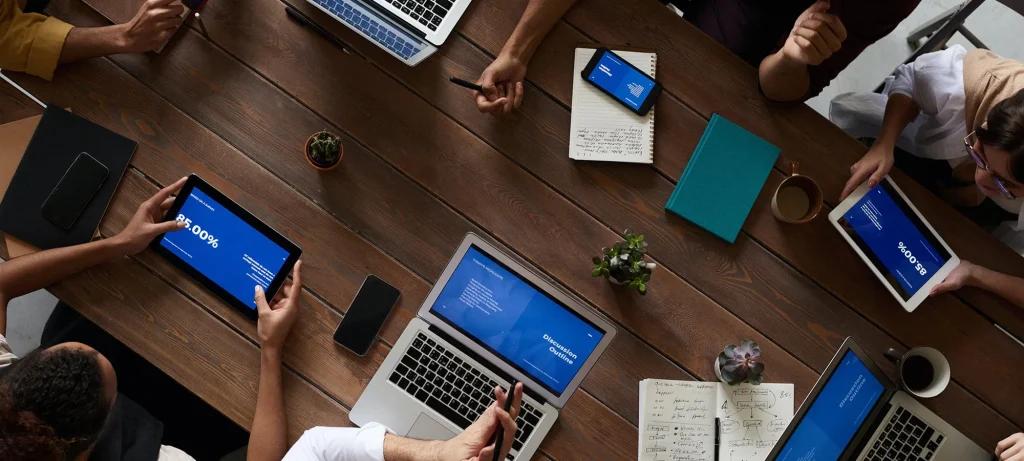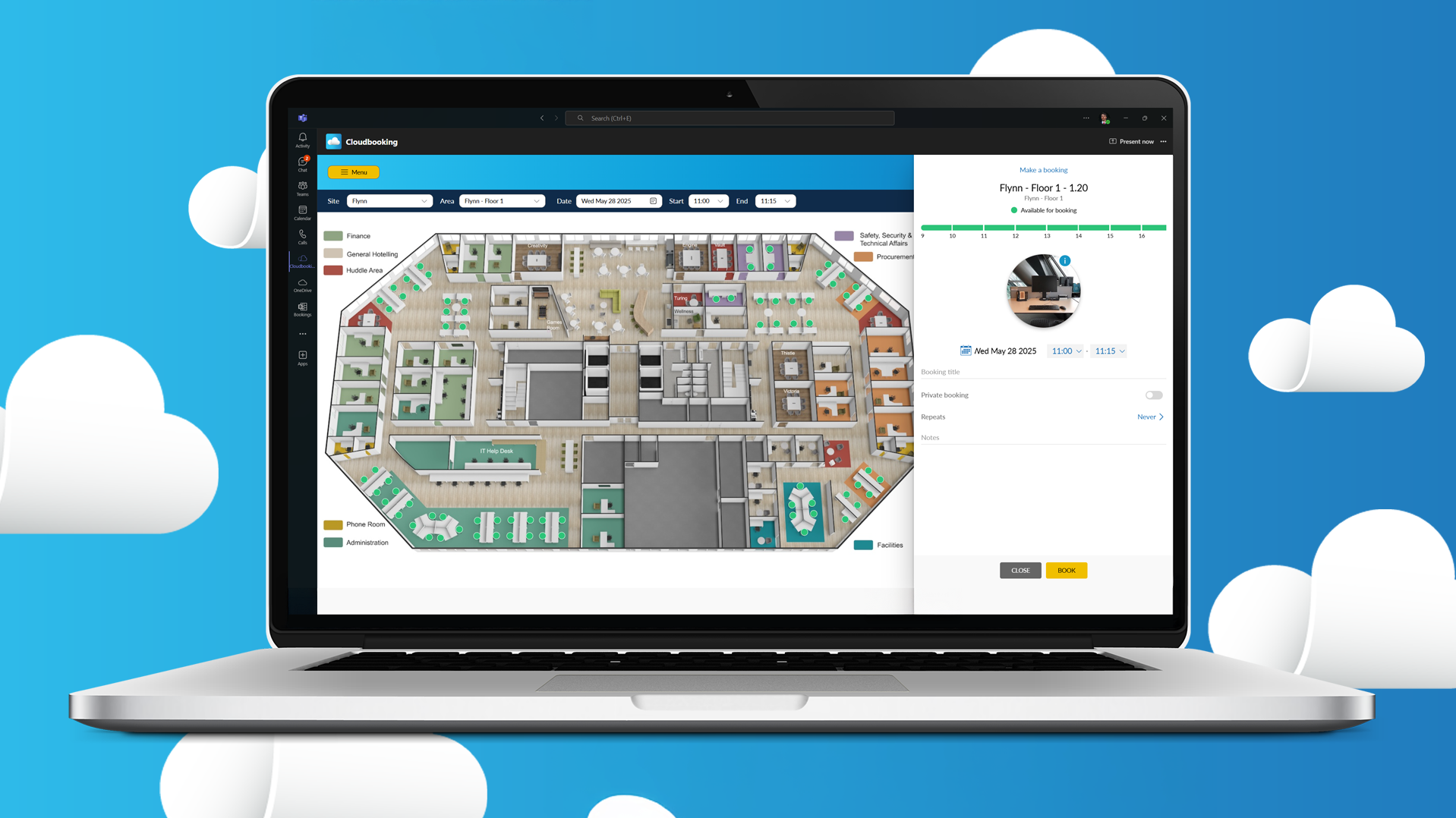
Smart technologies are increasingly being utilized in all areas to improve our lives. The Internet of Things (IoT) is revolutionizing the way we live and work. Smart offices are incorporating intelligent devices and connectivity solutions to improve productivity, collaboration, and space management. This post will explore how the smart office works and consider some of the key benefits this concept offers for businesses.
Get a free demo
Enquire about a no-obligation demo today and get an exclusive hybrid working research paper — for free. Created in partnership with YouGov, this invaluable guide provides essential insights into developing your own effective hybrid strategy. Click below.
What Exactly Is a Smart Office?
What is a smart office? A smart office is a hi-tech workplace that uses analytics and connected technology to help people work more efficiently and productively. In smart offices, analytics are used to understand how the environment can best serve its people and inform better working processes. Connected technology is used to enable connectivity and collaboration between in-office and remote individuals and teams.
Smart offices draw on a variety of different technologies and tools. This helps to support more productive, seamless, and automated working processes. Tools used in a smart office can include video conferencing software, meeting room software, desk reservation software, hardware tools, and analytics tools, giving insight into how the various spaces are utilized.
The Many Benefits of a Smart Office
There are many benefits to implementing smart technology within an office environment. Firstly, it helps to improve efficiency and productivity amongst staff. This is because it makes tasks much easier. It can also help automate many processes, freeing people to work on higher-value tasks rather than repetitive, menial ones.
This, in turn, allows people within a workspace to achieve their professional goals much faster and focus on higher-level skill development, which is suitable for both the organization and the individuals working within it.
Secondly, a smart office can be much more secure. This is because security devices such as WiFi sensors and security cameras can be incorporated. Data from these is easily accessible in real-time to those who need it. In addition, cloud-based solutions can help boost security and compliance within the workplace because they are managed by specialist companies that invest heavily in security.
Thirdly, a smart office gives greater convenience to those working within it, making the space more customizable and comfortable. This is because smart technology can allow staff to control aspects of their working environment, such as temperature control and advanced workspace booking.
Flexible Working Without Productivity Headaches
Fourthly, smart technology in the office can help to enhance collaboration and facilitate flexible working in a way that doesn’t compromise teamwork and productivity. This is achieved by using remote collaboration tools, which enable teams to connect and collaborate regardless of physical location.
This, in turn, leads to improved relationships within a workforce. This is essential for organizations looking to move to a more flexible way of working. Companies looking to shift to this kind of culture should implement smart technologies to streamline the process and ensure employee buy-in.
Smart office technology enables workers to have greater control over their schedules, working environments, and communications with colleagues. This helps to support greater autonomy and ownership over their work, leading to a happier and more productive workforce with a higher output level.
Finally, a smart office can help to reduce operational costs in several ways. Firstly, workplaces can access technology that allows them to manage real estate and space utilization. This provides valuable data on how space is being used and where space could potentially be redundant and sold off. In addition, smart devices can be used to reduce energy usage, benefiting the environment and reducing utility bills. Lighting and heating can be set to automatically turn off when a space is not in use, making a workplace much more energy efficient.
Must-Have Features of the Smart Office
Not all smart offices are created equal. Much like smartphones, some are better equipped than others which ultimately brings better benefits to the user. Let’s consider the features of a smart office that should not be overlooked.
One of the must-have features of a smart office is intelligent climate and lighting control. As touched upon in the previous section, this helps a workplace reduce carbon footprint at work and save on operational costs.
Intelligent climate control systems are capable of detecting usage patterns and preferences. This is done via simple touch screen input or intelligent sensors strategically placed to detect motion and activity. They can then regulate temperature and lighting accordingly. Companies can install smart thermostats, which can be controlled via mobile apps or web browsers. This gives employees control over their workspace, which, in turn, helps to boost morale, productivity, and staff retention.
Heating and lighting can switch off when spaces are not in use, saving energy and money. Systems are available which allow various aspects of climate control – including doors, windows, and lights – to be managed easily with a simple tap on a screen.
The Smart Meeting Room
Smart meeting rooms are another must-have feature of a smart office. These combine several features which help to improve and streamline the meeting process within an organization. Meeting management platforms can monitor usage within shared office spaces such as conference rooms, huddle spaces, phone booths, and hot desks.
Cloudbooking software enables employees to book required spaces ahead of time and view where their colleagues are, or will, be located. This speeds up the booking process and helps with space utilization. It also gives workers greater control over where and when they work and who they will be working with.
Smart meeting rooms incorporate software that allows users to request the necessary equipment and other extras such as catering, for example, all on the same platform. Meeting management systems handle reservations and send alerts to administrators and attendees. Facilities management teams can access this data to ensure all the necessary equipment and services are provided and that any events are adequately managed. This enables everyone to carry out their roles and ensures all are aware of any cancellations or changes regarding location or meeting time.
Smart screens can display who is using a space at any given time as well as details of upcoming reservations, how long the space will be occupied for, and for what purpose. This can help prevent traditional issues with holding meetings, such as unintended interruptions, double bookings, and room hogging.
Analytics can help managers by providing usage data that allows them to understand how their employees work best and enables them to better support their teams. Workspace booking platforms can enable managers to monitor where and when their staff are working and ensure everyone has what they need to do their jobs effectively at any given time.
Smart Management of Visitor Check-In
The best management systems for visitor sign-in also incorporate smart visitor management. This allows companies to automate the check-in process, monitor the number of visitors and their purpose for visiting, and provide directions supporting visitors to find their desired location or persons.
Video monitoring is another essential component within a smart office. Not only does this enhance security within the workplace, but it can also be connected to the desk booking and space utilization elements of a smart office. This allows for analysis of how office spaces are utilized and supports facilities managers in carrying out their roles.
Technology to Enable Smart Office Activity
Smart offices are powered by the Internet of Things (IoT), incorporating a combination of hardware and software solutions. Cloud-based technology is central to the smart office, as are some key smart devices.
Many hardware devices can help to support a smart office. Conventional office devices such as computers, phones, and mobile devices will, of course, be required. However, these must be up-to-date and capable of supporting the software, features, and level of connectivity which a smart office requires.
Information Collection and Display
In addition to these basic devices, smart offices typically have a variety of other hi-tech equipment. This includes smart screens strategically placed to provide the right information to the right people at the right time.
For data collection and the monitoring of people and spaces, smart cameras and sensors are a must-have. These can collect valuable data and communicate with other platforms and devices to analyze what is happening in the workspace and provide data on office usage. They can be connected to smart lighting and heating equipment to ensure the workplace functions intelligently to meet user needs and reduce operational costs.
Smart mobile devices are a must-have and should be allocated to all staff to ensure they can benefit from the interconnected smart office, wherever they are located. Devices must support the right platforms and provide easy access to all the necessary tools for all users. These can be used both inside and outside of the office for connectivity and workspace management.
A Dependable Internet Connection
A good internet connection is a must when operating a smart office as the technology and tools involved all depend on this. Organizations should ensure that their basic internet infrastructure is up to scratch – or consider upgrading it – before deploying smart tools and platforms. A good, reliable internet connection will ensure that everything runs smoothly and the system doesn’t fail.
In terms of software technology, organizations should look to specialist cloud-based platforms specifically designed to support the smart office environment. This includes remote connectivity tools as well as smart systems for room utilization and desk booking. With the world moving to a more flexible way of working, these tools are essential to facilitate modern working practices.
Organizations must ensure that the tools they invest in are user-friendly and meet the organization’s specific needs. Devices and software must be compatible and capable of connecting easily with the various elements of the smart office. It’s a good idea first to map out the features you would like to see in your smart office and then do some research to find the best solutions.
Seek expert advice and opinions on the technological aspects before investing to ensure the solutions you opt for are fit for purpose and meet the needs of everyone in the office. Smart technology should support people to work more efficiently and comfortably, not make their working lives more difficult by providing additional challenges or workload.
Hot Desking and Smart Office Work
Hot desking is becoming increasingly popular amongst organizations across many different sectors. Flexible working provides many benefits to both employees and the organizations they work for. Hot desking allows companies to save money by reducing the amount of physical workspace they provide. Rather than people being static in where they work, companies can offer a range of spaces tailored to meet different working needs. This allows teams to collaborate where needed, while individuals can utilize the areas they need for other purposes.
A smart office takes hot desking to the next level. It eliminates the potential issues with hot-desking, such as people simply turning and having to work wherever there is a spare desk and teams not being able to work together.
These issues can be eradicated with the right technology. Utilizing a comprehensive desk booking platform as part of the smart office can allow companies to support their flexible workforce better, control and accommodate visitors, and manage their spaces more effectively.
When workers can view desk booking information and book their workspaces ahead of schedule, hot desking can be taken to a new level. Individuals and teams can view where their colleagues will be at any given time and book a desk that enables them to collaborate with the right people. They can manage their working schedules, determining ahead of time where and when they will be working on any given day and with whom.
Organizations can create different working spaces for various purposes, such as meeting rooms, private cubicles, huddle spots, and recreational areas. These can then be managed effectively using the right technology to ensure optimal space utilization.
Once people have booked their workspaces, other aspects of the smart office can ensure they have a comfortable and well-equipped workspace. This helps to boost productivity and staff morale. While traditional hot-desking was often viewed as unfavorable by those working within these environments, smart office technology has transformed the experience beyond recognition.
This type of office management software can provide every team with the information they need to do their jobs more efficiently and effectively while supporting all aspects of the business. It can incorporate visitor management and provide data on all aspects of the physical environment, including working spaces and car parks. It allows administrators and facilities teams to do their jobs more effectively by instantly giving them access to the data they need.
As you can see, the smart office takes modern working to the next level, bringing an array of benefits to both workers and their organizations. Cloudbooking can empower your digital transformation with industry-leading smart office solutions, including our desk booking technology.
Let us help you connect with technology and implement a smart office for your business. Contact us now for a no-obligation product demo.


